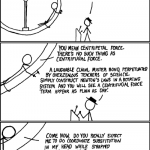centripetal force
Let me start with the video. Here is a guy flying a plane in a barrel roll and pouring some tea at the same time. Talk about multitasking.
How can he pour upside down? Well, there are two ways to look at this. First, I can look at this in the frame of the plane. For this case, I can invoke the fake force - centrifugal force. Oh yes, I am going to do it. You probably remember all your physics instructors warning you to never ever do this. Well, they say that because they are afraid you will do something bad with it. Here, I will only use the centrifugal force for good.
What is the…
It's odd that I have talked about these forces so much. First, I talked about how centrifugal forces were not real and the difference between centrifugal and centripetal forces. Then I talked about how sometimes, fake forces are good. Finally, I talked about the origin of the words centrifugal and centripetal. (note: "talked about" means wrote a blog post)
In thinking about centripetal forces, I realized that I could come up with a situation in which the centrifugal force is the centripetal force. This is great. I can end all the confusion between centrifugal and centripetal by making a…
Here is the deal. Why would you put a lot of effort into explaining something wrong? I just don't get it. Wouldn't it be easier and better to just not say anything? The particular show I am ranting about is the 2008 Punkin Chunkin on Discovery (I think). Fairly ok show, but they should have left the science out. The part that made me speak out was when they were talking about the different types of punkin chunkers. They have:
Compressed air
Catapult
Trebuchet
Centrifugal Force Machine
To explain these devices (the physics behind them), the show brought in the big guns. Let's bring…
Sometimes it is difficult to come up with new labs. Ideally, a lab should show use some of the basic physics principles as well as have something the students can measure. What to do with circular motion? I don't know how I forgot this, but here is a lab I used to do as an undergraduate student. I also like it because it doesn't really need fancy stuff like PASCO probes or anything. The basic idea is that a small mass is swung around in a circle with the tension in the string controlled by hanging a mass on the other end. Here, let me show you.
Circular Motion Lab from Rhett Allain on…
pre-reqs: vectors, kinematics
I haven't done a "basics" topic in quite some time. It's odd, I have used centripetal acceleration quite often, but I never derived the expression that I use. To get to the point, the magnitude of the acceleration of an object moving in a circle is:
Also, the direction of this acceleration vector is always towards the center of the circle the object is moving in. This is really not too difficult to derive (but it does use at least one "trick"). Let me start with an object moving in a circle at a constant speed. I am going to show to instances of the object…
It's odd that I have talked about these forces so much. First, I talked about how centrifugal forces were not real and the difference between centrifugal and centripetal forces. Then I talked about how sometimes, fake forces are good. Finally, I talked about the origin of the words centrifugal and centripetal. (note: "talked about" means wrote a blog post)
In thinking about centripetal forces, I realized that I could come up with a situation in which the centrifugal force is the centripetal force. This is great. I can end all the confusion between centrifugal and centripetal by making a…
A student in my office temporarily confused the words centripetal and centrifugal. This started me thinking about these two words. They mean different things, but do sound and look similar. I have previously talked about the difference between fake and non-fake forces, but let me quickly define these two:
Centripetal: This is the force needed to make something move in a circle. The force could actually be a number of things such as: friction, gravity, tension in a rope or any combination. Centripetal force is a name for a real force that has the role of making something move in a circle…
A couple of commenters expressed concern over the use of centrifugal force after my rant on the use of the word force. So, what is the deal with these two terms? Are they ok to use? Are they real forces?
First, are they real forces?
It depends on what you mean by real. What is a force? Here is a quick overview of what a force is. I previously talked about real vs. non-real forces. For me, I say that if the force is essentially one of the 4 fundamental forces then it is "real". With this definition, centripetal force would be real and centrifugal not real.
Centripetal Force
Centripetal…
Ever get sick of your life here on Earth? What about really getting away from it all; what if you wanted to live in space, orbiting the Earth, away from everyone. (At least for awhile, like a summer home.) What would you need to do it, and what would it consist of?
I propose an idea which I'll call a "space house," where I'll go through what I think is the cheapest and easiest way to get all the things you would need to comfortably survive in space for an extended period of time. First off, let's go over all the things a human would need to survive, while still having a good life, in space…
One of the worst teaching tools physicists use (and they almost all do it) is to tell students,
There's no such thing as centrifugal force.
What can you do when the top physics education website says, "It is important to note that the centrifugal force does not actually exist. We feel it, because we are in a non-inertial coordinate system." There's a very funny comic over at xkcd that goes as follows:
Well, what's the deal? What really goes on, physically, and what causes a centrifuge to work? Is your physics teacher right, or is there more to the story than "the centrifugal force does not…

